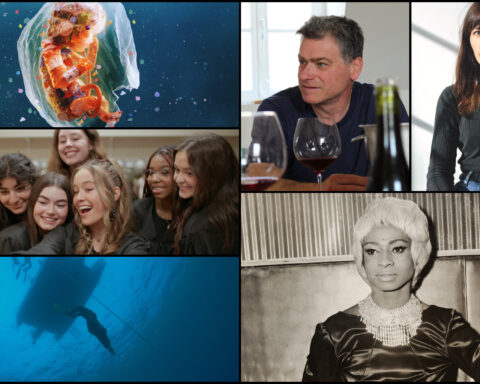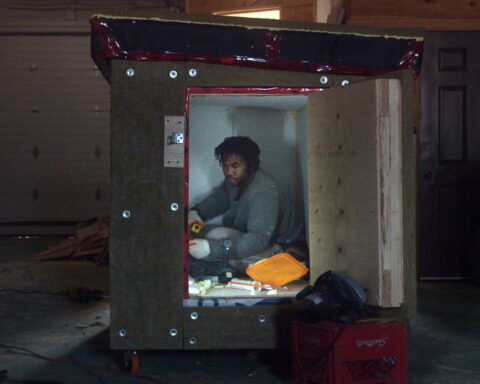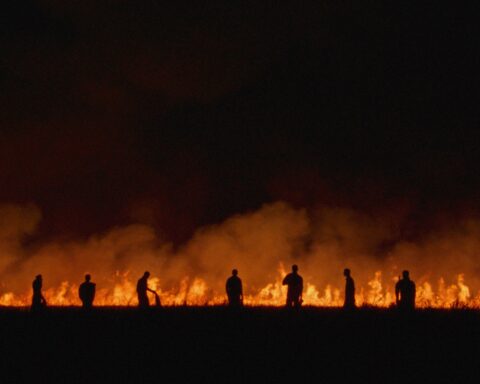Veteran director Jennifer Baichwal and her partner, cinematographer and producer Nick de Pencier, have collaborated with internationally acclaimed photographer Edward Burtynsky on what will surely be one of the top documentaries of the year. Watermark, co-directed by Baichwal and Burtynsky, is a cinematic essay—an “immersive experience,” according to Baichwal.
The film explores the many properties of water. Positively, this new documentary shows water as a cleansing source, a place of astonishing power, a spiritual force, and as the essence of the human body. By contrast, Watermark harshly reminds us of the pollution that is destroying water, how huge dams are harnessing its power while also destroying natural resources and communities—and perhaps most devastatingly, how water is a harbinger of what can happen to a worldwide industrial system that is creating climate change. Watermark takes viewers on a cinematic journey through 10 countries, offering many stories, among them: how water affects scientists in the Arctic, rice paddy workers, California surfers, Indigenous people in northern B.C., and a mass of spiritual seekers in southern Asia. It’s a vast exploration and, in some ways, a continuation of Manufactured Landscapes, Baichwal and de Pencier’s award-winning profile of Burtynsky. Watermark extends that film: Burtynsky is now a co-director and co-producer, as well as a cinematic subject. The three have worked together, meshing their talents to create a gorgeous and thoughtful look at water itself.
The film is part of Burtynsky’s “water project,” which also includes a major new book, parts of which we glimpse in the film. Burtynsky-Water, a publication by the noted art press Steidl, will also be available this fall. It’s a continuation of Burtynsky’s work, which is recognizable for his signature big-picture approach, both in terms of the large scale of his stunning photographs and the consequences of their environmental content.
Burtynsky’s previous projects have included investigations of mine tailings, quarries, ship breaking in Bangladesh, manufacturing in China and a global investigation of oil in all of its manifestations. His acclaimed publications include Manufactured Landscapes (2003), winner of the Roloff Beny Book Award; Burtynsky: China (2005); Edward Burtynsky: Quarries (2007); and Burtynsky: Oil (2009) among others. Over the last five years Burtynsky has photographed water from a global perspective that considers various topics including: distress, control, agriculture, aquaculture, waterfront and source.
Burtynsky was one of the inaugural winners of the TED prize, which has also been rewarded to such luminaries as Dave Eggers, Karen Armstrong, Bono and Edward O. Wilson. He is an Officer of the Order of Canada.
Jennifer Baichwal and Nick de Pencier have created award-winning documentaries since they started collaborating on the profile of novelist and composer Paul Bowles, Let It Come Down (1988). Since that acclaimed debut, they’ve made films on the photographers Shelby Lee Adams (The True Meaning of Pictures, 2004) and Edward Burtynsky (Manufactured Landscapes, 2006); the nature of debt—with the input of writer Margaret Atwood (Payback, 2012); and the role of coincidence in life (Act of God, 2008). They’ve won Genies and Geminis, a cultural prize at Hot Docs, an eco-hero award at Toronto’s Planet in Focus festival and the TIFF award for best Canadian film.
BF: Blake Fitzpatrick, for POV | EB: Edward Burtynsky
BF: Let me start by asking, why a study of water?
EB: In 2007, I was just finishing up with the oil project and it occurred to me that things were happening with water, and that water was a resource not unlike oil: we find it, we pipe it, redirect it and transform it into a useful product. I was doing a project in Australia, and almost every paper was commenting about how Australia was the first continent to be experiencing climate change and that the centre of Australia was drying back. You start hearing, time and time again, that we’re hitting limits—that water has limits, like oil has limits. The topic of water carried a lot of the ideas that I had already engaged with in the oil project. We’ve now created what one would call synthetic water. It’s not water in its natural state. It’s now water under our control. When it’s under our control, we can use it for many purposes ranging from agriculture to developing urban centres to industry. Water is a very powerful medium, probably one of the most powerful political mediums today. It can cause social upheaval, and it can calm social problems. But, to me it was clear that the difference between oil and water was that limited reserves of oil had a work-around, albeit a very difficult one. Water was more brutal, there was no work-around. It’s finite. If you don’t have it, you have to leave. To me oil and water are the two liquids of our time. But, if we don’t get water right, it could lead to the most destabilizing of all changes that we will experience. A change of not enough oil would certainly cause a lot of disruption, but water would be even more disruptive.
BF: In your oil and water projects you develop a rounded approach to the subject matter, following the full life cycle of resources from raw material to use to depletion, and to their environmental consequences. How has your trajectory as a photographer brought you to these global, epic subjects, and does this mark a shift from earlier work that looked at singular topics such as quarries?
EB: Right from the get-go, which was in the early ’80s, my choice of subject matter has been what I called the man-altered landscape. I went to open-pit mines and saw these large scale, man-made incursions into what largely is a totally natural landscape. The ship-breaking project in Bangladesh was a warm-up but my first big attempt at trying to take on a large idea was China. Quite frankly, it was daunting. To me, that project was really about trying to define how the Industrial Revolution has shifted from the West to China. We’ve all seen the industries unbolting their milling machines from our factory floors and bolting them to the factory floors in China, with labour at a fraction of the cost, and the same stuff coming back as cheap goods. Yet, when I started the project there was no corresponding imagery of that change. Even in 2000, I could not find anything that was supporting that idea, that reality. So, I started with Three Gorges Dam, saying, “Well, here’s the largest dam in the world being built” and that to me was a great metaphor for the hubris of China—the industrial might of it.
BF: You talked about discovering a lack of images in your initial research for the China project. How much time is spent researching sites before shooting and do you do this work or do you have researchers working for you?
EB: My work is research driven. The Water project started in 2008 when I got a call from National Geographic. They said: “We’re doing a whole issue dedicated to water. We’d like to sign you to do California.” I had already started my research, so I said, “Great, I can work with a phenomenal institution with an ability for deep research.” I needed to understand the topic and they started sending me all kinds of incredible information that their researchers were coming up with. California was actually a perfect central crucible for water, because 75 to 80 per cent of their water comes from out of state. It’s a negotiated space. We nicknamed the project “Plumbing California” because it was like a massive plumbing project of aqueducts, dams, diversions and reservoirs for out-of-state water to get to key centres in California. For 12 weeks I traversed California in all kinds of ways—flying, renting bucket lifts, driving it, and just reading about it so as to develop enough of a perspective on it. I think what I was looking for were the themes that had a sufficient scale to them, that showed a human mark and yet at the same time contributed something to the meaning of water, how we direct it, how we misuse it and how we experience the consequences.
BF: Watermark opens with the thunderous sound of water rushing through a dam. Viewers are presented with an abstract image of swirling and exploding clouds of mist and water that is difficult to decipher. This same scene is reproduced photographically in your book Burtynsky: Water. What does abstraction do for environmental imagery, and why be abstract with an issue that’s so closely tied to the survival of the planet?
EB: Well, my work has always tried to find that narrow line between form and content, where the content is still there for those who care to look for it. As a photographer, the form is something that has evolved over 30 years of making this kind of work and allowing my own intuition to find the image by cutting away until you come to something that has resonance. I’m interested in the experience of experiencing of a photograph, one that is almost disarming, evokes a sense of wonder or imparts certain types of information. Sometimes more information is imparted and sometimes less. But, I don’t see myself as a reporter or as a documentary photographer, in the classic sense of the word. I see myself more as someone who is exploring ideas and trying to find images that somehow will be recognizable within the arc of a body of work produced over 30 years. The signature of the work is one in which both information and abstraction are delivered while referencing art as visual conduits to ideas. My goal is to create something that is not too didactic or polemic, but something that is more interpretive. Whether you’re on the corporate side of the agenda or whether you’re on the environmental side of the agenda, the work can be used as a point of departure. It’s not an indictment of anybody or anyone. In fact, it’s more of a humanist thing—that we, as humans, are doing this. I’m not saying who’s right or wrong. I’m just saying, “We’re doing this, and here’s evidence.”
BF: Your work depicts exemplary cases of human activity in the landscape as you tend to go for the biggest dams and the biggest examples of the issues that you address.
EB: It was the only way, and I set this agenda 30 years ago. You may have an idea of what a mine or what a quarry is but how do you move the idea from the general to the specific? I thought the best way to do it was to look for the largest expression. So, all of my research has been looking at the largest examples of an activity. It just seemed to be a rational way to deal with these big projects. There’s also something that happens at that scale.
BF: Increasingly you have used a cherry picker, a helicopter or a fixed-wing airplane to reveal the massive scale of the sites that you photograph. In Burtynsky: Water and Watermark, the number of aerial shots and helicopter vantage points is astonishing. What draws you to the aerial perspective? How has your development as a photographer brought you to this extreme form of topographic photography?
EB: With the Water project, I first tried using a cherry picker. I did a 12-day trip with a cherry picker all across California. Even then I realized that a height of 50 feet wasn’t enough. I was trying to photograph the All-American Canal that goes through the California desert. I photographed with the cherry picker every which way I could but it just didn’t read the scale of an aqueduct going through a desert. So, I had to get up to the point where I could see the desert and see that aqueduct like a straw sucking water down through it. Similarly with farming—you can get a cherry picker and all you can do is get a view where you fill the bottom frame with corn or whatever. It isn’t a view that really speaks about the large-scale transformation of the land. I was interested in trying to say that farming is scale. Aerial photography allowed the subject to tell me where to position the camera and how to identify the scale of an activity.
BF: The first pictures in the book are of the Gulf oil disaster. This seems to be the ultimate Burtynsky topic, one that is so obviously impactful and of consequence. How does this fit into the overall Water project?
EB: Well, the oil disaster in the Gulf of Mexico happened in 2010. I started thinking about the Water project in 2007. In 2008, I started researching. In 2009, I started shooting in California. So, by then my categories were already there. If you look at my landscapes, you’ll see that I don’t chase disasters. My photographs are of intentional landscapes. These are all planned landscapes, although they look like accidents sometimes—like, “Holy Jesus, we did that?” But, they are intentional landscapes. When the oil spill happened, it was interesting because all of the sudden it’s like Mary Shelley’s Frankenstein story is now upon us. In other words, we create something in the lab and it gets out. Now it’s a mess and we can’t stop it. It’s an example of overreach and of not fully understanding risk. To me, the Gulf spill became the meeting point for oil and water in an unhappy collision. This was a way to make visible the two liquids that I’ve been working on for 12 years.
BF: Finally, as this is your first project as a co-director, is film a form of expression that you might come back to?
EB: I think so. To me, it seems to be a natural place to extend my work and to challenge me in other ways. When I went to Ryerson, I loved film. However, I looked around and I thought that the chances of me being able to go out there and make films about the things I wanted to say—and I was still forming my ideas—I just didn’t have what I thought it would take. Yet, in stills, I could do it myself. I didn’t need the resources and the group of people around me. Now with 30 years of working on a set of ideas, I find I can make that transition and start to be more intellectual, and that film is something that I’m naturally drawn toward. I don’t have the time to go to film school, but working alongside skilled and good people, I get to learn while doing, which is a fun way to learn. I don’t think that this is the end of my relationship with film. How I’m going to express it again, I don’t know, but for now it’s enough to just get this one done.











